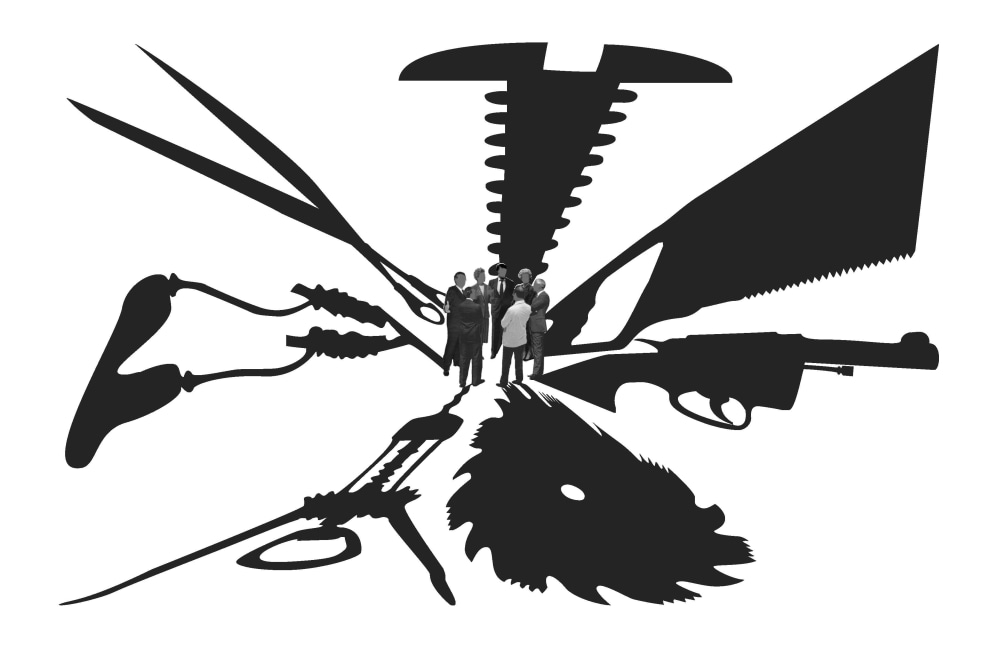

Regina Silveira, Encuentro, 1991/2002
Regina SIlveira's one-person exhibition Outros Paradoxos at Museo de Arte Contemporáneo de la Universidad de São Paulo.
The institution's press release follows:
Regina Silveira is one of the greatest Brazilian artists of her generation. Internationally recognized for her work and her career as an artist, researcher and teacher, Silveira actively participated in MAC USP’s institutional history at different times. Moreover, she became a prominent figure in debates about art as a form of knowledge after the University of São Paulo opened the first Graduate Program in Visual Arts in Brazil, in 1974.
In 2019, MAC USP received the donation of 42 works by the artist in partnership with Gallery Luciana Brito, completing a significant set of her production in the museum’s collection. To mark this important donation, we present the retrospective exhibition Regina Silveira: Other Paradoxes. The title refers to The Saint Paradox, one of the artist’s works incorporated into the museum’s collection in 1994, but mainly to Silveira’s characteristic restlessness in questioning life and art. This exhibition presents engravings produced in the 1960s, when Silveira was a young woman recently graduated from the Institute of Arts of UFRGS in Porto Alegre, her experiments with image appropriation and video art from the 1970s, as well as proposals for urban interventions and some of her most recent installations. The exhibition also offers the possibility of comparing many of the works with the sketches and projects they originate from, or even with some of the spatial studies made with scale models. The visit experience is rounded out with document showcases and informative videos.
This exhibition also seeks to draw attention to certain aspects of Regina Silveira’s production that are further enhanced by the retrospective format. First, the political dimension is a remarkable feature of the artist’s works that are part of the MAC USP collection, reinforced by the recent donation received. Silveira’s way of problematizing her reality does not involve approaching explicitly political issues or using propagandistic images. She works between the lines, with aspects that, although seemingly banal, reveal social tensions and contradictions. As an example, we have the pieces in which Silveira appropriates photojournalistic images, such as the series “Middle Class & Co.”, where a human mass appears compartmentalized within geometric shapes.
Gender is another element deserving of attention. Silveira has been able to break through the barriers of artistic recognition that often favors the male artists of her generation. By performing large works designed for public environments, she assigns visibility to the female presence in art through her ability to design and mobilize the art circuit, in Brazil and abroad, for the execution of her proposals. The artist’s ability to update her techniques and materials throughout her trajectory is also remarkable, adapting her creative process in the face of multiple challenges, including the use of new media, starting from the 1970s, and more recently of digital processes. Silveira thus enters a field that, for the historiography of art, has been understood as masculine: the project. She works from the idea, going through all the stages of realization, a fundamental process for the development of her artistic propositions.
Finally, we highlight in her body of work the recurrence of perspective used as parody, often referring to the propositions of French artist Marcel Duchamp. Questions about the codes of representation, the games of light and shadow, the boundaries between art and non-art, and irony are present in different ways in Silveira’s works. Experiments with anamorphosis, for example, were the basis for the album “Anamorfas”, her master's thesis developed within the then newly created Visual Poetics research line of the Department of Fine Arts of ECA USP. They are an unfolding of the artist’s interest in visual perception and the phenomenon of distortions derived from the point of view. Distorted shadows of everyday objects – such as a comb, saw, fork and hammer – when overlapped with other everyday objects, help Silveira create unusual associations. Shadows, arranged as impossible extensions of figures representing power, suggest that utensils are dangerous or even deadly weapons.
This retrospective is part of the expansion network of the 34th São Paulo Biennial, a partnership between MAC USP and the Fundação Bienal de São Paulo, and reopens the museum’s exhibition annex that underwent renovations to readjust its floor in 2018-2019. This space, ideal for site specific projects, installations and large works, is geared to artistic experimentation. To reopen it with Regina Silveira is to reaffirm such a character, proper of a public university museum.